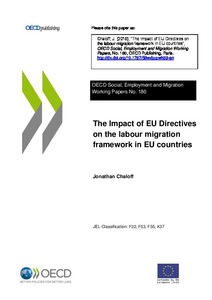The impact of EU Directives on the labour migration framework in EU countries
"This paper is part of the joint project between the Directorate General for Migration and Home Affairs of the European Commission and the OECD’s Directorate for Employment, Labour and Social Affairs on "Review of Labour Migration Policy in Europe". This document has been produced wit...
| Main Author: | |
|---|---|
| Institution: | ETUI-European Trade Union Institute |
| Format: | TEXT |
| Language: | English |
| Published: |
Paris
2016
OECD |
| Subjects: | |
| Online Access: | https://www.labourline.org/KENTIKA-19103242124919214249-The-impact-of-eu-Directives-on.htm |
| Summary: | "This paper is part of the joint project between the Directorate General for Migration and Home Affairs of the European Commission and the OECD’s Directorate for Employment, Labour and Social Affairs on "Review of Labour Migration Policy in Europe". This document has been produced with the financial assistance of the European Union. The views expressed herein can in no way be taken to reflect the official opinion of the European Union. Grant: HOME/2013/EIFX/CA/002 / 30-CE-0615920/00-38 (DI130895). This paper is a revised version of an earlier paper (DELSA/ELSA/MI(2015)3) presented and discussed at the OECD Working Party on Migration in June 2015. The paper examines the mechanisms for labour migration management across individual European countries. Distinguishing between high- and low-skilled workers, it investigates the policies aiming at attracting and retaining qualified migrants. It finds that in EU countries there are several different forms of barriers to labour migration, each of which is affected differently by EU legislation. It then specifically focuses on the Student, Researchers and EU Blue Card Directives, studying their effects on the real policy framework in the EU countries affected, in terms of approach. It finds that the first two directives have had a modest impact on the legislative framework, which was largely aligned with the Directive prior to transposition in many cases. The Blue Card scheme is compared in detail with national schemes, in terms of the key parameters of the Directive (criteria, processing standards, benefits, etc.). The paper examines the use of a salary threshold and its different effect according to the country in which it is applied. The paper concludes by examining the impact of these directives on recruitment opportunities, attractiveness and levelling the playing field among EU countries. It explores some options for adjusting the policies in the future." |
|---|---|
| Physical Description: | 180 p. Digital |

